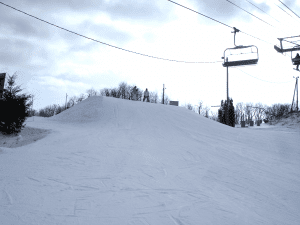 Do you know how much your resort spends on its snowmaking process?
Do you know how much your resort spends on its snowmaking process?
We frequently field questions about the cost to make snow, but before we get to the answer, let’s review how snow is made. Natural snow is made when a super-cooled water droplet condenses around a nucleus of dust or pollen in the sky. Water vapor freezes onto the ice crystal and grows into a snow flake as the flake falls through the atmosphere. Since Mother Nature does not always cooperate with the timing and location of snowstorms, ski resorts have learned to manufacture snow. The basic recipe for manufacturing snow is to combine water and compressed air and spray it out of a tube called a snow gun. In actuality, the process is a lot more complicated. The type of weather, the type of terrain, and the type of technology used to mix water and compressed air all impact the cost to make snow.
Weather
Weather is in a constant state of flux. Weather fronts, daytime heating, and nighttime cooling bring about constant changes. Temperature, humidity, and wind speed are also constantly fluctuating. As such, weather conditions may only be favorable for making snow for a short period of time or sometimes not at all.
Wet Bulb Temperature
The relationship between temperature and humidity is known as the wet bulb temperature. The wet bulb temperature is the lowest temperature that can be reached by evaporating water into the air, and will always be less than or equal to the air temperature. Both temperature and humidity must be low enough for snowmaking. It is possible to make snow with temperatures above freezing, but only when humidity is very low. When humidity is very high, the temperature may have to be several degrees below freezing in order to make snow.
The ability to make quality snow also varies with the wet bulb temperature. If the air is too humid, the moisture on the water droplet will not be readily evaporated, resulting in wet, slushy snow. A wet bulb temperature below 20°F is ideal for producing the desired dry snow.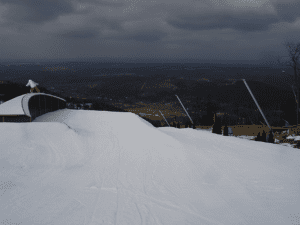
Wind Speed
The wind can impact snowmaking efficiency in two ways:
- It directly affects the emergence of snow from the snow gun, giving the snow nuclei more or less hang time. The snow’s hang time dictates the size of the snowflakes.
- It directs the flow of the snow once it exits the gun. If a percentage of the snow lands in the woods or anywhere other than the trails, the cost of snow production increases by that percentage of loss to those non-recoverable locations.
Topography
The topography, the size and shape of the ski trails, the proximity of the hill to water supplies, and the geology all impact the cost for a resort to manufacture snow. Trails with a higher vertical–the change in elevation from the bottom of the trail to the top of the trail–will require a greater effort to pump water to the top than will a trail with a lower vertical. Depending upon the snow gun technology, compressed air lines or electric power lines will also have to be run along the sides of the trails. A ski slope with a very steep pitch may pose difficulties when installing the supply lines and support structures. Depending upon the elevation change and its impact on weather, more snow guns may be required at the lower elevations due to less favorable temperatures that are experienced at higher elevations.
Proximity to Water Supplies
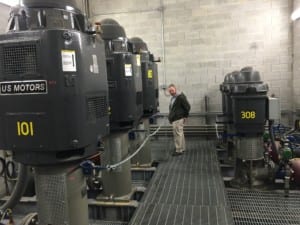 Snowmaking requires a lot of water. Some ski resorts are able to extract water directly from nearby lakes, rivers or streams and pump it up the mountain. Other resorts may have to withdraw the water from more distant sources and stockpile it in ponds more adjacent to the ski hills. The size of the water source, for example a small stream, may limit the water withdrawal rate and water may have to be extracted over an extended period of time to fill the storage ponds. Some ponds are engineered to capture surface runoff so that water is continually reused as the snow melts during the season. There are also often regulatory permitting obstacles for withdrawing the volume of water necessary to operate the ski resort.
Snowmaking requires a lot of water. Some ski resorts are able to extract water directly from nearby lakes, rivers or streams and pump it up the mountain. Other resorts may have to withdraw the water from more distant sources and stockpile it in ponds more adjacent to the ski hills. The size of the water source, for example a small stream, may limit the water withdrawal rate and water may have to be extracted over an extended period of time to fill the storage ponds. Some ponds are engineered to capture surface runoff so that water is continually reused as the snow melts during the season. There are also often regulatory permitting obstacles for withdrawing the volume of water necessary to operate the ski resort.
Size and Shape of the Trails
The number of snow guns needed for each trail depends largely upon the length and width of the trails. Longer trails need more snow guns in order to provide adequate snow coverage. Wider ski trails may also require more snow guns to provide adequate coverage. Narrow trails require shorter guns. Wide trails require longer guns to cover larger areas more efficiently. Wide open trails may be more impacted by wind than narrower trails and thus may require more of the shorter guns so that snow is not blown away before it reaches the ground.
Geology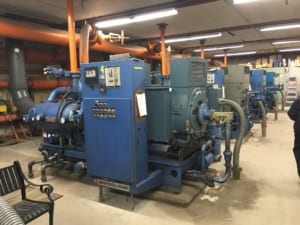
In order to prevent freezing of water lines, piping must be run underground. If there is only bare rock and no soil, it may not be possible to bury water lines. In that case, all lines have to be drained between snowmaking events in order to prevent freezing. Installation of platforms and towers for snowmaking equipment may not be possible depending upon the surface and subsurface of the land at the resort.
Technology
There are three main types of snow gun technologies that may be controlled by both manual operators and automation technologies.
Internal-mix Air-Water Snow Guns
Internal-mix air-water guns have a chamber where the water and air are mixed together and forced through an atomizer. The temperature of the water droplets is above freezing as the water/air mixture exits the snow gun. The temperature of the mixture drops rapidly due to evaporation and cooling effects of expansion of the air and the droplets crystallize into snow as they fall to the ground. Traditional internal-mix air-water guns allow continuously variable water-to-fixed-air ratios to adjust to the weather conditions. These guns use a centralized source of compressed air that is piped throughout the resort to the location of the snow guns. These types of guns use the most compressed air and, as a result, have the highest operational costs. This equipment costs about $5,000.
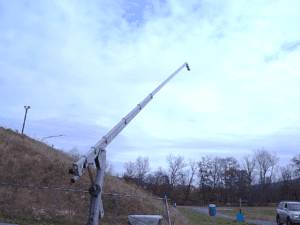 External-mix Air-Water Snow Guns
External-mix Air-Water Snow Guns
External-mix air-water snow guns, often referred to as low-energy snow guns, use a nozzle to spray water as a fine stream and use separate air nozzles to shoot air through the water stream to break the stream into fine water droplets. Newer guns use internal mixing valves known as nucleators to help create a nucleus for water droplets to bond to as they freeze into snow. These types of guns are usually installed on higher towers to create more hang time for forming snow crystals. Traditional external-mix air-water guns allow continuously variable water-to-fixed-air ratios, but use a lot less compressed air than internal-mix air-water snow guns, especially at lower temperatures. They require a much higher water pressure and utilize much lower air consumption to operate compared to internal-mix guns. External-mix guns cannot overcome strong winds. These guns use a centralized source of compressed air that is piped throughout the resort to the location of the snow guns. This equipment costs range between $5,000 and $6,000.
Fan Guns
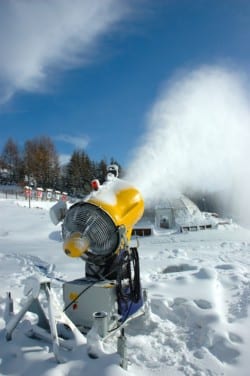 Fan guns are often referred to as snow cannons or snow fans. Fan guns use on-board compressors and fans to most efficiently create air movement to go with the water. Compressed air and water are sprayed out of the gun through several nozzles and then the airflow generated by a large fan blows the air/water mix as a mist into the air to achieve a long hang time. Fan guns have anywhere from 12 to 360 water nozzles on a ring on the front of the gun through which the fan blows air. The fan guns function well in moderate winds and broadcast snow over large areas. These guns use a centralized source of water, as do all snow guns, however they do not require a centralized source of compressed air as they contain an on-board compressor. By use of an on-board compressor and fan, fan guns use 10-25% of the energy required to operate other types of snow guns. The fan guns do require a source of electricity to operate the on-board compressor and fan so there is an expense of running electricity to each gun. Fan guns are also significantly more expensive than traditional snow guns. The cost of the fan gun itself may range from $28,000 to $35,000. The towers and platforms needed to mount the fans come with an additional fee. The final cost for installation of snow fans may reach $50,000 apiece.
Fan guns are often referred to as snow cannons or snow fans. Fan guns use on-board compressors and fans to most efficiently create air movement to go with the water. Compressed air and water are sprayed out of the gun through several nozzles and then the airflow generated by a large fan blows the air/water mix as a mist into the air to achieve a long hang time. Fan guns have anywhere from 12 to 360 water nozzles on a ring on the front of the gun through which the fan blows air. The fan guns function well in moderate winds and broadcast snow over large areas. These guns use a centralized source of water, as do all snow guns, however they do not require a centralized source of compressed air as they contain an on-board compressor. By use of an on-board compressor and fan, fan guns use 10-25% of the energy required to operate other types of snow guns. The fan guns do require a source of electricity to operate the on-board compressor and fan so there is an expense of running electricity to each gun. Fan guns are also significantly more expensive than traditional snow guns. The cost of the fan gun itself may range from $28,000 to $35,000. The towers and platforms needed to mount the fans come with an additional fee. The final cost for installation of snow fans may reach $50,000 apiece.
Snowmaking Automation
Snowmaking automation can allow ski resorts to take advantage of very small snowmaking windows and also offer opportunities to reduce energy use. Most resorts experience 24-hour periods where wet-bulb temperatures only fall into snowmaking range for a few hours, often associated with nighttime atmospheric cooling. Snowmakers often do not have sufficient time to turn valves and make adjustments to the snowmaking systems during this window. With automation, guns can be started and stopped in a matter of minutes. They can also be controlled to much higher tolerances, enabling the automated system to consume significantly less compressed air and produce better quality snow under varying weather conditions. Automation also reduces manpower requirements and associated potential exposure to injury.
As ideal temperature windows are shortened due to annual rising temperatures, automated snowmaking systems allow for the production of snow when conditions are optimal. Automated systems can adjust individual guns to temperature, humidity, and even fluctuating wind speeds.
As you can imagine, there are many possibilities for automation, and costs can be highly variable depending up configurations and selected features.
Advantages of automated controls
- The likelihood that snowmaking needs to start before or extend beyond non-peak times is reduced.
- Startup tuning period reduces the need for ongoing operator intervention.
- The equipment does not need to operate in standby mode while guns and fans are manually tuned for full production.
- Sub-optimal motor and pump operating conditions, which are electrically inefficient while system is only partially producing, are reduced.
- Ability to turn multiple delivery units off or on as a group.
- Remote control of individual delivery units is available, reducing startup and standby times.
So How Much Does it Cost to Make Snow?
The cost to make snow is highly dependent upon the weather, the terrain and the technology. Based upon our experience, our client’s costs to make snow (depending mainly upon snow gun selection and to a lesser extent upon weather) have ranged from $70 to $2,100 per acre-foot including electric, pressurized water delivery and compressed air delivery to each snow gun.
There is no one particular snow gun or automation technology that is perfect for every resort. Various gun technologies deliver performance at different wet bulb temperatures, different wind conditions, and different trail and elevation configurations. Some resorts already have certain infrastructure in place such that may not be economically feasible to switch to certain technologies. However, every resort we have studied has realized tremendous energy savings by replacing some of their outdated snowmaking equipment.
Many of our clients had no idea of the up to five-fold difference in relative energy consumption costs between the different technologies or the cost-benefits that could be realized through automation. The good news is there are also opportunities for electric utility rebates for making energy efficient investments in new snowmaking technology!
Read more about how EMS helped Blue Mountain Resort exceed their sustainability goals and learn how you can get similar results for your business!



Someone recently told me about making snow. I always thought, get some water, a freezer and a fan, and we could even have snow in Honolulu. I was totally wrong. I appreciate you helping me learn more about what really goes into making snow and how much it could cost.